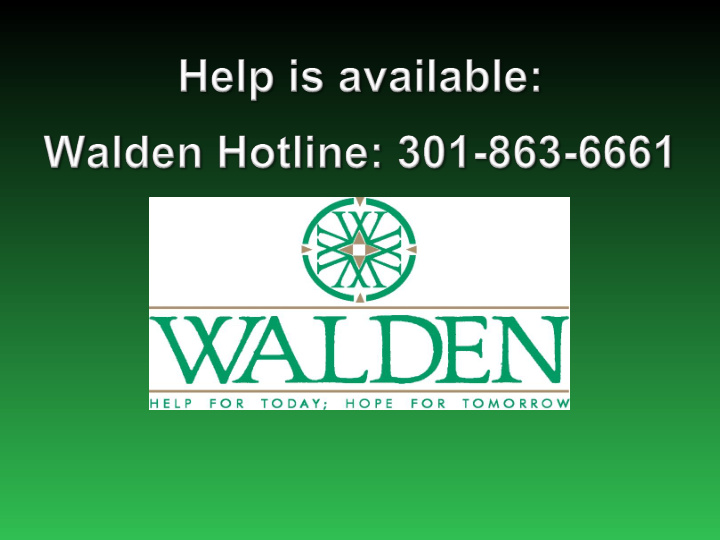



Objectives for Our Time Today • Scope of Problem • Facts about Opiates • Workplace Impacts • Student Impacts • Family Impacts • Walden’s Ability to Assist • Our Shared Challenges • Briefing from Law Enforcement • Questions and Answers • Next Steps
How big is the elephant in the room? Nationally: -Prescription drugs are the most commonly abused substance by teens; access to opiates is increasing for teens* Local Trends: -12 th grade students reporting use of a prescription opiate at least once without a doctor’s prescription: males 20%; females 16%** -9-12 th grade students who report trying heroin at least once: 4.5% (state average is 5%)** -While misuse is experienced among high school aged youth, opiate addiction is particularly an issue among 18-30 year olds -Admissions for treatment of prescription opioid substance and heroin use are dramatically up since 2008 at Walden • Monitoring the Future Study **YRBS data
The Opiate “Elevator Speech” • Almost all young Heroin users misuse Rx painkillers first • Common opiates, painkillers, include: Vicodin (hydrocodone), Percocet, OxyContin, Oxycodone, Fentanyl , Demerol and Codeine • Rx painkillers and heroin product similar effects but heroin is cheaper to those whose tolerance for opiates has caused them to need more for any effect • Misuse can occur by using the pill form itself or crushing the pills to be snorted or injected • Heroin can be smoked, snorted or injected • Most street heroin is “cut” with sugar, starch or quinine. Strychnine or other poisons can also be added • Overdose risk is increased for heroin users because most users don’t know strength or true contents of substance they are using • The vicious cycle of use starts with an intense euphoric rush and quickly becomes a pursuit of the next “fix” to feel normal and then to “keep the sick off” • Most potent
Impact on Workplace • About 68% of all adult illegal drug users are employed full or part time. This group is more likely to be involved in a workplace accident and potentially harm others or file a workers’ compensation claim. What might misuse on the job look like? Absenteeism, presenteeism, longer and more frequent breaks, lateness, MIA chunks of time, high accident or error rates, difficulty concentrating, confusion, lower job quality and output Inappropriate behavior, becoming emotional, being withdrawn Small or large value items missing How to respond: Don’t ignore the problem. Offer employee and supervisor education. Offer a plan to assist the employee with an effective intervention. Follow Substance Abuse/Workplace Policy/Plan and include random drug testing of employees.
Impact on Students Students report a number of stressors that might influence risk to substance misuse: 43% report having been really sad, scared, angry or stressed out lately* Access to substances for youth: home, neighborhood, on school campuses* immediate access: 35% refusal: 57% • Even in the midst of concern re: opiate misuse, alcohol is a risk that should not be ignored or disassociated. Each year, approximately 5,000 youth under age of 21 die as a result of underage drinking. • In the YRBS 2011 national data: 9% of students reporting using alcohol or marijuana at school or on campus. Using either on campus was associated with dramatically higher odds of exhibiting all 9 serious health risks (including in car with intoxicated driver; depression symptoms; intimate partner violence; suicide attempts) - In St. Mary’s, 31% male, 25% female students in 12 th grade reported binge drinking 20% of all 11 th and 12 th grade students reporting using marijuana at least - once in last 30 days *12-17 year olds, The Cove/DFZ
Impact on Families Addiction of a family member can be like a duck shaking water off – everyone and everything around the duck gets wet. Believe it – it can happen in any family. • Open, honest conversation • Actively watching for signs and symptoms for the progressive nature of misuse: Experimentation Social use Problem use (consequences, sacrifices of life to use begin Addiction/chemical dependency When a loved one needs help: • Encouraging sober time with loved ones (positive reinforcement) • Encouraging assessment and treatment • Positive Communication • Real boundaries • Family needs help, too
How we can help: Education • Walden can offer: – Workplace Workshops on Opiates – SBIRT training – alcohol and drugs – Teen Brain/Teen Addiction Workshops – The Truth about Vaping – Youth Services Professionals Addiction Workshops – Family Education Workshops & Support Groups – Youth Mental Health First Aid
How we can help: Treatment • Assessments in Lexington Park and in Waldorf • Substance misuse and mental health treatment • Psychiatric and mental health counseling • Licensed child and adolescent psychologist in Lexington Park • Adolescents & Adults! • 24 Hour Crisis hotline: 301-863-6661
How we can help: The Cove/DFZ • The Cove/DFZ offers eligible youth: – A safe, sober and fun place to be – Homework support – Life Skills – Mentoring – T to T peer support groups – Snacks – Transportation help – Enrichment outings & fun field trips – Family & Friends weekly support groups for those with a loved one with problem drug or alcohol behavior
Our shared challenge: identifying and referring youth EARLY • Walden has seen a reduction in referrals for treatment of students from the schools • How can we make the Screening, Brief Intervention, Referral &Treatment (SBIRT) process more effective and useful for the middle and high schools?
Recommend
More recommend